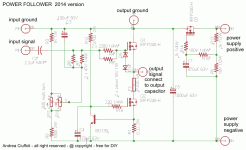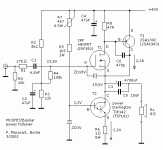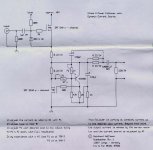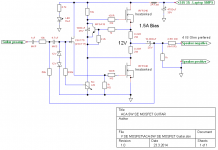The sound with my two way loudspeaker is wonderful.
Remove those LM7808 and LM7908 (replace with LM317 based regulator) and you should hear more wonderful sound.
I have never found any implementation where the LM7808/7908 IC doesn't hurt the sound, more so in a transparent/simple circuit like this.
Hi Jay!
Thanks for your reply and advise!. I had thought about replacing LM7xxx by LM317 and LM337, but it happens that the LM337 will suffer a significant deterioration in its impedance and PSRR from the 2 or 3 KHz and more. (the PSRR can be as low as 30dB).
I want to implement the cascode CCS mode (with two units of the LM317, instead of using the LM337).
Can you advise me any other options?
Greetings
Thanks for your reply and advise!. I had thought about replacing LM7xxx by LM317 and LM337, but it happens that the LM337 will suffer a significant deterioration in its impedance and PSRR from the 2 or 3 KHz and more. (the PSRR can be as low as 30dB).
I want to implement the cascode CCS mode (with two units of the LM317, instead of using the LM337).
Can you advise me any other options?
Greetings
Hi Diego,
I don't understand electronics as well as you. Your schematic confused me. Are you sure that the regulator capable of supplying class-A amp current? What amp is this? What is the wattage? Are you sure you can get 0V at the output (direct coupled)? If so, I think this is an improvement, provided that the power supply is upgraded. I like chokes for this purpose.
I don't understand electronics as well as you. Your schematic confused me. Are you sure that the regulator capable of supplying class-A amp current? What amp is this? What is the wattage? Are you sure you can get 0V at the output (direct coupled)? If so, I think this is an improvement, provided that the power supply is upgraded. I like chokes for this purpose.
Hi Diego,
I don't understand electronics as well as you. Your schematic confused me. Are you sure that the regulator capable of supplying class-A amp current? What amp is this? What is the wattage? Are you sure you can get 0V at the output (direct coupled)? If so, I think this is an improvement, provided that the power supply is upgraded. I like chokes for this purpose.
Jay:
The circuit is a voltage follower based on mosfet. Voltage gain is slightly less than 1. The circuit has current gain. LM317T regulator serves as a source of constant current of 0.5 Ampere. The circuit operates in pure Class A up to a maximum power of 0.95 watts (on an 8 ohm load). Currently I use it connected to the output of a CD player that delivers 2 V rms maximum, so the maximum output power at 6 ohms is 0.66 watts.
I have intentions of changing the constant current source for improved high frequency response. Would using two LM317 units operating in the cascode mode.
PS: Sorry for my English.
The circuit operates in pure Class A up to a maximum power of 0.95 watts (on an 8 ohm load). Currently I use it connected to the output of a CD player that delivers 2 V rms maximum, so the maximum output power at 6 ohms is 0.66 watts.
I have intentions of changing the constant current source for improved high frequency response. Would using two LM317 units operating in the cascode mode.
Is this a headphone amp? I think most headphones have higher than 8 ohm impedance? I'm not familiar and do not have experience with headphone amps...
And, are you sure you already have good enough analog amplification after the DAC inside your CD player?
Jay:
I use this amp with normal speakers, I do not use it with headphones. My listening room is not very large. Its output power is more than enough for me. Could be used with headphones, but reducing its power output.
You can watch a recording I made on Youtube.
Search for "Common Drain MOSFET Amplifier. Pure Class A (part 1 ) ... to ... ( part 6)"
Grettings
I use this amp with normal speakers, I do not use it with headphones. My listening room is not very large. Its output power is more than enough for me. Could be used with headphones, but reducing its power output.
You can watch a recording I made on Youtube.
Search for "Common Drain MOSFET Amplifier. Pure Class A (part 1 ) ... to ... ( part 6)"
Grettings
For me the most interesting version is those with BjT PNP boosting (Sziklai darlington - Ladislav Bunta's advanced circuit) - go therefore to
ImageShack® - Online Photo and Video Hosting
Imageshack - p83f3gb0.gif
diyAudio
check also my post 924 and associated about follow link:
http://www.diyaudio.com/forums/pass-labs/66822-sewa-seven-watt-amplifier-93.html
To get Aleph emitter follower one must implement additional devices according the second picture (German version).
ImageShack® - Online Photo and Video Hosting
Imageshack - p83f3gb0.gif
diyAudio
check also my post 924 and associated about follow link:
http://www.diyaudio.com/forums/pass-labs/66822-sewa-seven-watt-amplifier-93.html
To get Aleph emitter follower one must implement additional devices according the second picture (German version).
Attachments
Last edited:
For me the most interesting version is those with BjT PNP boosting]
So at last you found it! You are the best in internet search. If you cannot find it, who else can 😀
I will build this and compare side by side with other class-A such as SEWA.
BTW, any info on Power Follower 99 modified for preamp duty?
by checking of this listing I have fond it:So at last you found it! You are the best in internet search. If you cannot find it, who else can 😀
I will build this and compare side by side with other class-A such as SEWA.
BTW, any info on Power Follower 99 modified for preamp duty?
Schaltungskonzepte mit "Single Ended" Transistor Verstärkerstufe im Ausgang - open-end-music-professional
by checking of this listing I have fond it:
Schaltungskonzepte mit "Single Ended" Transistor Verstärkerstufe im Ausgang - open-end-music-professional
Cool. Ostripper has just posted a genesis OPS. I think I have built what looks like a SE version from John Broskie long time ago so to make sure I searched TubeCad site but couldn't find what I need (I haven't fixed my broken harddisk containing a lot of scematics).
Hello:
I have two Macura MPF questions, both oriented toward non-hi-fi use, like maybe a guitar amp.
1) I am interested in making a low power Class A amp, ballpark 1W, and having seen the Macura MPF in higher power versions, wonder if there is a reason to not do this (better way).
2) With no specific power output goal at this time, I'm curious if the bag of 47N60 MOSFET's I found is a candidate for a MPF, or better as a power supply pass element? It seems like a rather huge part and if it works 'best' at a particular bias point, then there would be a particular power level that corresponds with that. Trying to use an oversized part at a much lower bias current might be in a less linear region. The very high gfs of some of these big parts is a curiosity, and I suppose it isn't critical in a follower...but it leads me to wonder what difference it makes.
Thank you
Murray
I have two Macura MPF questions, both oriented toward non-hi-fi use, like maybe a guitar amp.
1) I am interested in making a low power Class A amp, ballpark 1W, and having seen the Macura MPF in higher power versions, wonder if there is a reason to not do this (better way).
2) With no specific power output goal at this time, I'm curious if the bag of 47N60 MOSFET's I found is a candidate for a MPF, or better as a power supply pass element? It seems like a rather huge part and if it works 'best' at a particular bias point, then there would be a particular power level that corresponds with that. Trying to use an oversized part at a much lower bias current might be in a less linear region. The very high gfs of some of these big parts is a curiosity, and I suppose it isn't critical in a follower...but it leads me to wonder what difference it makes.
Thank you
Murray
Member
Joined 2009
Paid Member
with regards Pavel's circuit:
Given that the Darlington has much higher transconductance than the FET it should have less distortion ? in other words, use the FET as the current sink and the Darlington as the Follower ?
Given that the Darlington has much higher transconductance than the FET it should have less distortion ? in other words, use the FET as the current sink and the Darlington as the Follower ?
Guitar Amp
If you want great low power guitar power amplifier, look at my slightly modded ACA (Amp Camp Amp by Nelson Pass).
Hello:
I have two Macura MPF questions, both oriented toward non-hi-fi use, like maybe a guitar amp.
1) I am interested in making a low power Class A amp, ballpark 1W, and having seen the Macura MPF in higher power versions, wonder if there is a reason to not do this (better way).
2) With no specific power output goal at this time, I'm curious if the bag of 47N60 MOSFET's I found is a candidate for a MPF, or better as a power supply pass element? It seems like a rather huge part and if it works 'best' at a particular bias point, then there would be a particular power level that corresponds with that. Trying to use an oversized part at a much lower bias current might be in a less linear region. The very high gfs of some of these big parts is a curiosity, and I suppose it isn't critical in a follower...but it leads me to wonder what difference it makes.
Thank you
Murray
If you want great low power guitar power amplifier, look at my slightly modded ACA (Amp Camp Amp by Nelson Pass).
Attachments
Member
Joined 2009
Paid Member
with regards Pavel's circuit:
Given that the Darlington has much higher transconductance than the FET it should have less distortion ? in other words, use the FET as the current sink and the Darlington as the Follower ?
bump...
What is the advantage of the Sziklai variation?
Better for clean or the guitar option?
I think I have some of the '1302's, some power Darlington's but the only megamosfets I have right now are some 47N something monsters.
Does the Sziklai pair option make MOSFET choice more flexible?
Thanks
Better for clean or the guitar option?
I think I have some of the '1302's, some power Darlington's but the only megamosfets I have right now are some 47N something monsters.
Does the Sziklai pair option make MOSFET choice more flexible?
Thanks
I love this sort of amplifier.
Pavel Macura's idea is great.
It is a good replacement for pure Class A amplfiers.
To build a little preamplifier that can feed the circuit is not difficult.
More info at Project 83 - MOSFET Power Follower
Where is also recommended DoZ preamp for use.: Minimalist Discrete Hi-Fi Preamp
Nobody could be disappointed if building this amplifier!
🙂
Pavel Macura's idea is great.
It is a good replacement for pure Class A amplfiers.
To build a little preamplifier that can feed the circuit is not difficult.
More info at Project 83 - MOSFET Power Follower
Where is also recommended DoZ preamp for use.: Minimalist Discrete Hi-Fi Preamp
Nobody could be disappointed if building this amplifier!
🙂
Member
Joined 2009
Paid Member
If it's for guitar, then the clipping behavour and sound, while clipping, are most important imo. That's why tube amps always sound better with guitars.
I love this sort of amplifier.
Pavel Macura's idea is great.
It is a good replacement for pure Class A amplfiers.
To build a little preamplifier that can feed the circuit is not difficult.
More info at Project 83 - MOSFET Power Follower
Where is also recommended DoZ preamp for use.: Minimalist Discrete Hi-Fi Preamp
Nobody could be disappointed if building this amplifier!
🙂
Hey Lineup, great to see you back!
Don't forget Ciuffoli's classic (w new PCB):
the Power Folllower

( virtual gnd; 'batt supply')
Re, vis a vis
Power follower 99c Vs Zen
Pavel Macura's MOSFET Power Follower
Cheers Lineup
Last edited:
- Status
- Not open for further replies.
- Home
- Amplifiers
- Solid State
- Pavel Macura's MOSFET Power Follower


